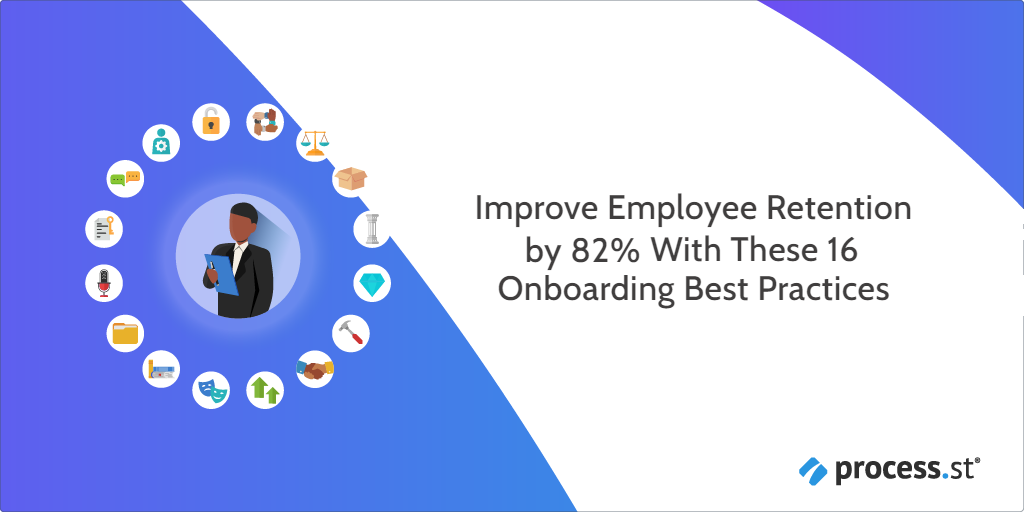
Glassdoor reports effective employee onboarding increases retention by 82%.
“Organizations with a strong onboarding process improve new hire retention by 82% and productivity by over 70%”
Now consider the cost of hiring a new employee is between ~6-9 months salary (the average salary for a customer success manager in the U.S. is ~$85,000 annually). When you do the math, it becomes clear how costs start to rack up.
If you’re a SaaS company dedicated to growth and gaining a competitive edge, this is an unnecessary cost that every team, including your customer success team, should avoid.
One of the best ways to improve retention is by focusing on your employee onboarding. That’s what we’re going to look at in this Process Street article.
We’ll explain how we, along with Salesforce, Netflix, and Intercom, onboard our customer success managers.
And if you’re going to invest in onboarding, making sure your customer success managers are onboarded effectively is a good way to effectively hit two birds with one stone. Your CSMs are in charge of customer onboarding, so by providing a solid employee onboarding foundation to orient them, you’re also laying the foundation for a solid system of client onboarding.
By the end of this article, you’ll have learned the 16 employee onboarding best practices used by these top 4 international tech companies. Although these onboarding best practices are specific to a customer success manager role, they’re applicable across most business departments.
- Why onboarding is important for retention
- 16 onboarding best practices (used by top tech companies)
- How to implement onboarding best practices in your company
Why onboarding is important for retention

Looking at the top Fortune 500 companies, it is said that the most effective organizations are those that spend a good chunk of time, energy, and resources dedicated to the employee onboarding process.
You’ve no doubt heard the phrase employees are your greatest assets. With this in mind, it comes as a no-brainer that you should invest in your greatest assets. Having effective manager onboarding ensures adequate investments are made from the get-go.
This is especially true when it comes to onboarding your CSMs.
You see, your CSMs are the ones at the top overseeing the work done by your customer success team. This team supports the transition of your sale prospects to active users of your product/service. As such, your organization’s revenue stream is completely reliant on your CSMs. Their effectiveness and proficiency in their role will directly impact your bottom-line.
An effective onboarding strategy can bring the following benefits to your CSMs and your customer success team as a whole:
- Talent retainment: As Ron Carucci, co-founder and managing partner at Navalent says, if you want to retain top talent then you need to spend a good amount of time and money to acquire them. You, therefore, need to invest in the best onboarding practices – luckily you’re in the right place to do that.
- Improves on-the-job performance: Organizations with standardized onboarding processes experience a 62% greater new hire productivity relative to those that don’t.
- Betters employee engagement: A HR Drive report stated more than 1/4 of employees/managers were willing to quit a job within their first 90 days. Organizations are solely responsible for employee commitment, satisfaction, and engagement. It’s important to use milestones such as 30, 60, 90, 120, and 365 days on the job to facilitate positive experiences and check-in with employees.
- An improved employer brand: Not planning your onboarding processes, or worse still, not having a structured onboarding program, will damage your employer brand as well as the effectiveness of new employees.
With effective CSM onboarding, you’ll nurture and retain top talent to bring in more, high-quality sales leads, positively impacting your bottom-line.
16 CSM onboarding best practices
An onboarding strategy is a process of integrating your new employees into a company and its culture, as well as giving new hires the tools and information needed to become a productive member of your team.
Looking for ways to get your employee onboarding strategy right can be a minefield. This is why we at Process Street decided to do the hard work for you.
For this article, we’ve delved into the onboarding strategies used by Salesforce, Process Street, Netflix and Intercom to give you 16 top onboarding best practices.
Let’s learn from the best to be the best and see how we can perfect your onboarding strategy.
Salesforce’s employee onboarding strategy
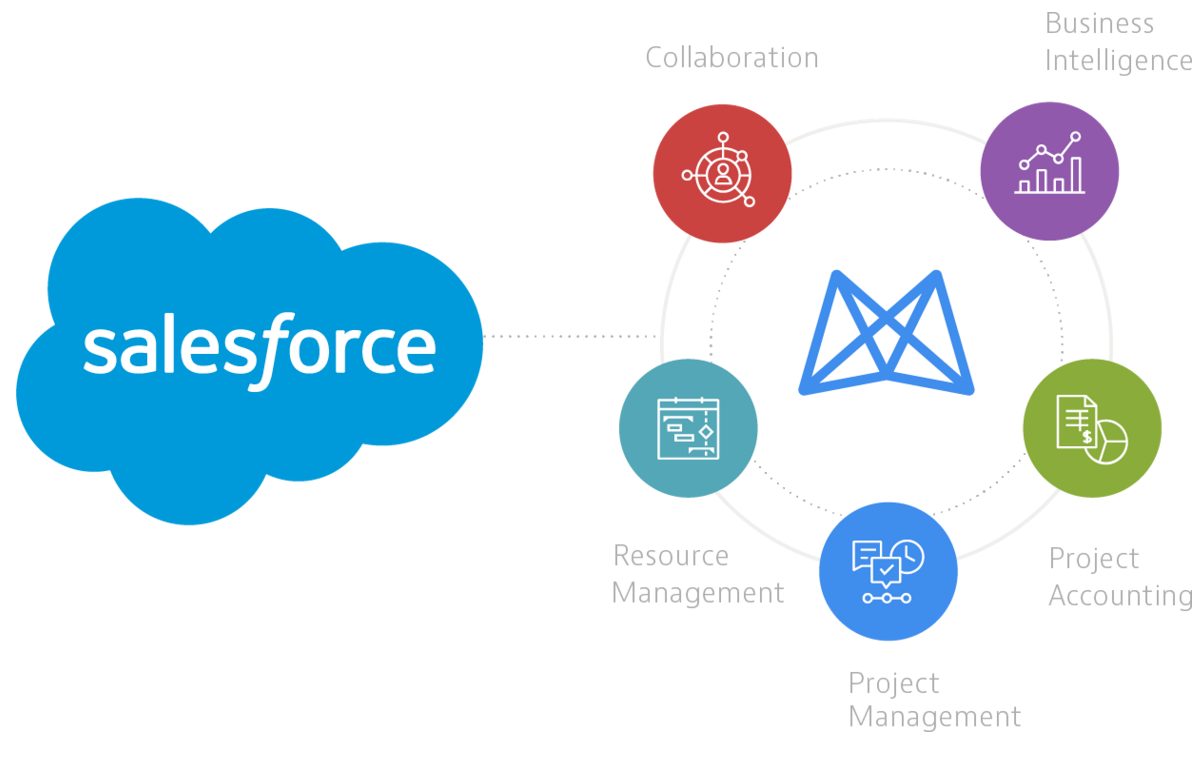
As one of the largest tech companies in the world, Salesforce has over 49,000 employees in 28 countries and is a SaaS champion when it comes to engaging with and looking after their employees.
The Fortune 100 Best Companies to Work For® 2018 report evaluates thousands of workplaces to determine the top 100 spots in America. This list ranked Salesforce as No. 1 in 2017.
What is Salesforce doing right?
Employee onboarding best practice #1: Provide adequate resource access
Parisa Molanazadeh talks about what it’s like to be a Success Director at Salesforce:
“I have access to all the wonderful resources created by my peers so I don’t have to constantly reinvent the wheel when trying to resolve a specific customer challenge“. – Parisa Molanazadeh
Sharing resources and information in the workplace can provide benefits such as:
- One truth to enable better decisions.
- Transparency, promoting employee trust.
- Efficient collaboration promoting synergy.
- Integrated workflows to make it easier to build value.
Providing the relevant resources to Salesforce’s CSMs gives these benefits right from the start.
Employee onboarding best practice #2: Communicate
Molanazadeh also stated that…
“I can easily collaborate with other team members at Salesforce and request help from anyone in the organization. – Parisa Molanazadeh
Salesforce leverages technology for easy team-wide communication and collaboration. For instance, Process Street is used for cross-team and intra-department collaboration via business processes and workflows, and Chatter is used as an internal instant messenger tool.
This means new CSMs can follow seasoned company top performers to share best practices, easily join conversations, and tag content they like. With these technology tools, new hires have visibility into what each department is doing and what their peers are working on.
Employee onboarding best practice #3: Personalize
Instead of swamping new hires with tons of information on their first day, Salesforce slowly drips out key information at the right time via a year-long, automated, and personalized new employee welcome email campaign.
A personalized journey (known as journey orchestration) is built using a drag-and-drop interface visually showing the timeline for each step. For instance, below is a common template used for an employee’s first week with the company.
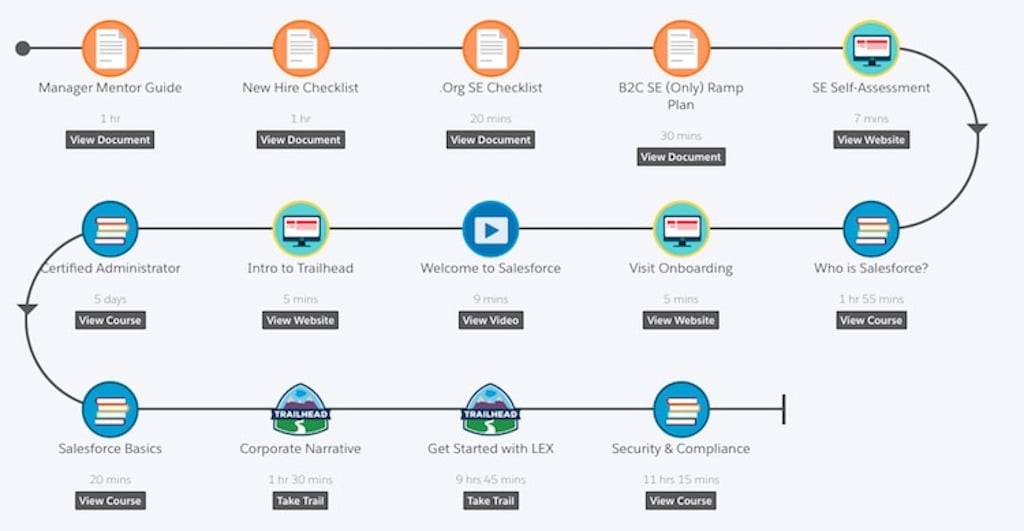
Each step in the new hires’ journey is strategically spaced, sending automated, personalized messages followed by either email, push notifications, or SMS text.
This new hire journey has been refined over the years to cater to different roles, with each CSM experiencing a specific, personalized onboarding journey.
Employee onboarding best practice #4: Give freedom
“[…]you get a lot of freedom of what projects you want to be involved in” – Customer Success Graduate, Salesforce Glassdoor Reviews
Salesforce has a special graduate program for its customer success team. This program gives graduates the freedom to choose their projects for exposure, meaning they can progress to more senior roles but have personal accountability and autonomy in how they get there.
Studies indicate that having the freedom to choose which tasks to accomplish has a positive impact on team creativity, mediated by intrinsic motivation.
Once more, extensive studies into accountability find it boosts employee performance.
By giving new hires the freedom to adjust their work following personal preference, Salesforce leverages the benefits of accountability and autonomy during the hiring process.
Netflix’s employee onboarding strategy

In 2019, Netflix employed <ahref=”https://www.statista.com/statistics/587671/netflix-employees/” target=”_blank” rel=”noopener”>8,600 full-time workers, almost double the number recorded in 2016.
71% of employees stated they would encourage their friends to become co-workers, making Netflix officially the best place in the world to work beating the likes of Google, Facebook, Amazon, and Apple.
Let’s dive into Netflix’s employee onboarding strategy to grasp what the company is doing well.
Employee onboarding best practice #5: Focus on company culture
“The freedom and responsibility culture in practice allows you the space to do your best work” – Former Netlfix Employee, Salesforce Glassdoor Reviews
A strong and unified company culture sets a clear and positive business/brand identity. Concerning the onboarding process specifically, a bettered company culture attracts and retains top talent, and in this case, we’re talking top CSMs.
At its core, the Netflix company culture is about people over process, offering generous benefits and extensive training.
Netflix’s culture is designed to support and attract employees…
“…who love to build and deliver results.” – Current Employee, Netflix Glassdoor Reviews
Candidates with bad attitudes, big egos, and poor work ethics are bypassed to maintain a solid and supportive working environment.
“During the hiring process, look for soft skills such as empathy and emotional intelligence, and try to envisage how the candidates will slot into the team you’re placing them with.” – Peakon, Netflix Company Culture Focuses on “People over Process”
The focus on building a strong company culture is reflected across all Netflix departments, from the customer success team to software development and HR.
Employee onboarding best practice #6: Tell the truth
Netflix ditches performance improvement plans (PIP’s), describing them as giving few benefits, leading to a drawn-out process that renders employees feeling unmotivated and frustrated.
Instead, Netflix asks leaders and senior team members to have honest conversations and offer generous severance packages enabling people to regroup, then retrain, upskill, or find a new career.
By telling the truth Netflix avoids following rigid processes that will only delay the inevitable, making it difficult for all parties involved.
When an employee is underperforming, feedback is not sugar-coated. Netflix makes the point of being fully-transparent to harbor respect and trust from their staff.
“People can handle anything, as long as they’re told the truth” – Patty McCord, Harvard Business Review, How Netflix Reinvented HR
Research shows that companies who promote honest feedback and open communication have a 270% higher ROI over the 10 years relative to those that don’t.
We know that CSMs hold the brunt of an organization’s revenue stream on their shoulders. It makes sense that focusing on building trust during CSM onboarding will substantially capture this high ROI.
Employee onboarding best practice #7: Introduce employees to the product early
There’s little argument that the best way to learn a new product is by using it. Especially important for CSMs who need to be product experts.
Netflix lets new hires tackle huge projects right away, encouraging employees to use the product regardless of whether there’s a business reason to do so or not. This sets up the new hires for success from day 1.
This is also a top onboarding strategy we use here at Process Street:
“Trial-by-fire. We like to throw CSMs into the deep-end, early on, but also provide excellent support, creating a safe environment for mistakes to happen. The challenge means onboarded CSM learn quickly” – Customer Success Team Leader, Blake Bailey
Give new CSMs the opportunity to tackle a range of projects that incorporate product/service use.
To find out more about Netflix’s onboarding process, read: The 4 Netflix HR Practices That Took Us From Average to Awesome.
Process Street’s employee onboarding strategy
Process Street is a rapidly growing workflow management software company, securing $12 million Accel-led series A funding in February 2020.
If you’re a fast-growing organization like Process Street, you’ll want to focus your efforts on effective onboarding to retain top talent.
As mentioned earlier, studies predict that every time a business replaces a salaried employee, it costs 6-9 months salary to onboard someone new.
These are costs no growing business wants and can be avoided with effective onboarding, shown to improve employee retention by 82%. This is why Process Street has worked hard to get employee onboarding right. And today, we share our secrets.
Employee onboarding best practice #8: Provide structure
Onboarding for the customer success team at Process Street relies on a set schedule and calendar for the first 1-2 weeks. This gives new hires the structure needed for them to know what they should be doing and when.
“Structure: We have a rough set schedule and calendar for the first 1-2 weeks so new employees know what they should be doing and when” – Customer Success Manager, Brian Ralston
The structured onboarding process is transcribed into a Process Street checklist, and distributed around the department for all new customer success employees to receive the same onboarding treatment.
For instance, check out our Employee Onboarding Checklist below. Following this checklist ensures consistency for each new hire taken on.
Click here to access our Employee Onboarding Checklist!
Our Employee Onboarding checklist is free for you to use. Simply create your Process Street account and get started (it will probably take about 2 minutes).
You can edit our Employee Onboarding Checklist so it’s suited for your specific needs.
Edit any given checklist by adding features such as:
- Stop Tasks: Meaning the user cannot progress in the onboarding process until all relevant stages are complete.
- Role assignments: Meaning the relevant user can be assigned to specific tasks. For instance, checking employee paperwork might require more senior management. Senior management can be assigned as required.
- Approvals: Meaning senior management can review and approve tasks such as assign the first project. This streamlines team coordination and the review process, ensuring nothing slips through the cracks, with items given acceptance/rejection as required.
You’ll want to…
“Design a process that you best think covers all the necessary aspects of the role. Document it so that everyone has insight into how it will roll out – Jason MacMurray, VP of Customer Success
Learn how to document and edit processes in Process Street by watching the below video:
Employee onboarding best practice #9: Document everything as a process
“[We have] a highly detailed wiki or repository where new employees can search for answers to commonly asked questions or processes related to their role with answers – Brian Ralston
To complete a given task as per your set standards, an employee will need to follow the process.
As you’re probably aware, we at Process Street ❤ love ❤ process documentation – that is, detailing each step for every business operation, to give full transparency over how to get work done.
This means onboarded employees can find answers to their queries by pulling up the relevant checklist from our template library and running the process.
If an onboarded employee is stuck at a particular section in that process, they can ping the line manager and say “hey, I’m stuck on task 8, for the checklist X.” The line manager then knows exactly which process the candidate is running and where in the process the candidate is stuck, reducing back-and-forth and confusion.
“Everything that you need to know and everything you need to do is part of a checklist, which has a regular run link. These run links can be presented to someone you’re hiring, and can be put into a form email. The new employee can click on the run links and onboard themselves. When we have our first meeting, the new employee has done most of the onboarding themselves, and can ask specific questions” – Customer Success Team Leader, Blake Bailey
Documenting business operations and then storing them in a template library is an excellent way of providing onboarded CSMs with relevant resources that are both actionable and easy to find.
Sign up to Process Street and create your free account to get started.
Employee onboarding best practice #10: Re-visit the onboarding process
“By bringing processes on, we could identify inefficiencies in the hiring process” – Customer Success Team Leader, Blake Bailey
If you have no documented onboarding system, it’s easy for tasks to be missed during the hiring process, like employee background checks and reference checks.
Process documentation gives full transparency, helping identify process bottlenecks, unnecessary tasks, and areas where the process can be improved.
“…we are constantly re-visiting the process – Jason MacMurray, VP of Customer Success
Employee onboarding best practice #11: Have social calls
As we’re a remote team, social calls are extremely important to us at Process Street.
When I first started as a Content Writer, my main task was to set up social calls with the relevant team members across the marketing department. From these chats, I understood my colleagues on a personal level, outside of work responsibilities. Thinking about the impact of these calls on a company-wide scale, a sense of community is established which is important for creating a positive company culture.
“[Its important to]…focus on the social aspect as this is a big part of company culture” – Customer Success Team Leader, Blake Bailey
Employee onboarding best practice #12: Roleplaying scenarios
Customer success managers must know how to direct (or redirect) conversations with customers or industry leaders when the dialogue becomes challenging.
You can use documented processes to guide your CSMs during typical scenarios that may come up in their role. Using Process Street’s Conditional Logic feature in your documented processes will give the element of flexibility needed to adjust conversations depending on responses given.
However, sometimes conversations will veer far away from a given script meaning CSMs need to know how to anticipate and adapt their responses in accordance.
Structured theoretical scenarios and guided role-playing are great teaching tools helping CSMs work their way through challenging conversations, and learn how to maintain customer satisfaction. Practicing before being thrown into the fire can help defuse newly hired CSM stress and anxiety.
“At Process Street we conduct roleplaying scenarios with clear, concise, detailed instructions” – Customer Success Manager, Brian Ralston
Once your CSMs have practiced, your aim is to get them in front of the customers as soon as possible.
“ We have our CSMs sit in on as many customer conversations as we can until they learn the use cases and how to address obscure customer questions. We also let them know it is ok to not know the answer. It’s better to ask questions than to give the wrong answer“. – Jason MacMurray, VP of Customer Success
Employee onboarding best practice #13: Ramp up responsibility slowly while providing a challenge
“[At Process Street]…we ramp up the responsibilities well, i.e. we make sure that our CSMs are up to speed with each tool/system before letting them loose on customers” – Customer Sucess & Customer Content Creation, Ellie Mahoney
I remember my first swimming lesson as a child and feeling petrified. I’d envisioned standing on the poolside and then being pushed into deep water to fend for myself.
If this ever did happen during a child’s first swimming lesson… I can imagine not many would attend.
The same principle applies when it comes to employee onboarding. If you push your employees into the deep end before they’re ready and without the appropriate support, expect extended deadlines, poor employee satisfaction, and inadequate work quality as your employee fights to keep their head above water.
Instead, give appropriate instruction, training, and experience so CSM can rise to the challenge of their role and excel.
Intercom’s employee onboarding strategy
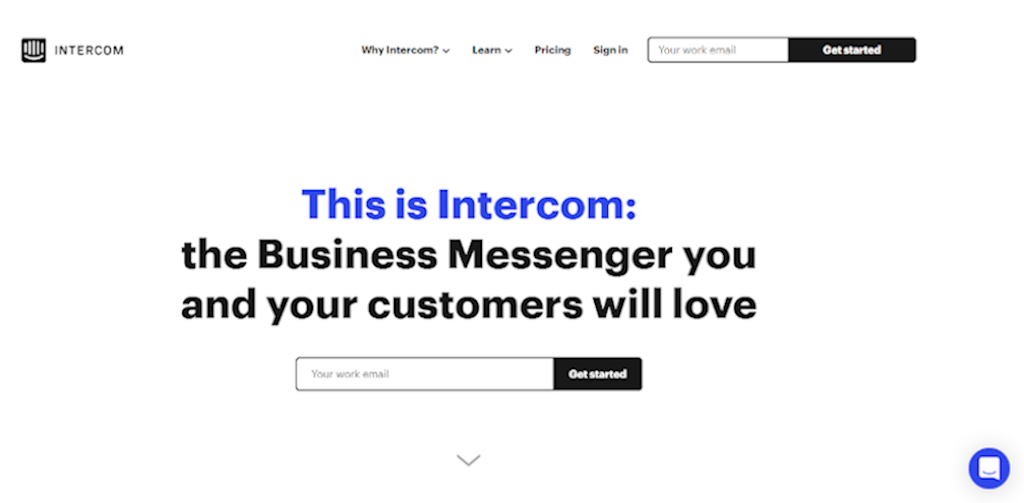
Intercom offers businesses an integrated help desk and knowledge base to solve customer problems faster, giving customer assistance whenever it’s needed.
The company has 630 employees and is ranked 3rd among its top 10 competitors. Intercom’s entire business model is built to create better customer relationships, and the organization’s success lies from doing that well. That requires effective nurture from the top during the CSM onboarding process.
Before we close off this article, let’s discover Intercom’s top CSM onboarding strategies.
Employee onboarding best practice #14: Provide a mentor and a buddy ♀️
Right, these 2 aren’t the same thing.
New employees at Intercom have a personal point of contact during their first 2 weeks – a buddy – who can answer their questions and introduce themselves to the team and expected workflows.
However, Intercom recognizes that a buddy can’t carry the full weight of responsibility for each new hire, and that’s where mentors come in.
A team can have multiple mentors leading different workshops and lectures, which is dependent on their area of expertise. Your CSM can familiarize themselves with other departments and working styles.
“Mentoring shouldn’t be seen as a task any less inferior to your day-to-day work. It might not look high-impact immediately, but the impact of good mentoring reveals itself over time.” – Intercom, Successful teams are built on smart onboarding
Employee onboarding best practice #15: Break information down into thematic units
This best practice builds on strategy #13, ramp up responsibility slowly while providing a challenge.
A customer support team needs to know the ins and outs of the product/service you provide, e.g. what features are relevant to the customer and when. With so much product/service knowledge to pass on, it can be easy to overwhelm an employee.
Break down product/service information into small digestible blocks, presented intuitively and linearly so your new hires can make connections between the different thematic parts.
Employee onboarding best practice #16: Onboarding never stops
“Intercom provides a world-class onboarding and training experience.” – Senior Sales Manager, Intercom Glassdoor Reviews
We couldn’t agree more with Intercom on this one, indeed employee onboarding never stops. Once you’ve covered every item on your list, don’t expect to have fully self-sufficient hires in a matter of weeks.
I’ve been at Process Street for nearly 2 years, and I’m still learning. But that’s an expectation, as, like with Intercom, Process Street recognizes onboarding as an opportunity for ongoing learning and growth. This is true regardless of department/role.
“A lot of opportunity for branching out and learning new things.” – Software Engineer, Process Street Glassdoor Reviews
Find out how you can support your employees effectively with an employee development plan, read: Employee Development Plan: Top CEOs Use One, and So Should You (Free Template).
How to implement onboarding best practices in your company
In this article, we’ve taken a deep dive and looked at the onboarding best practices for 4 top SaaS organizations.
Although we have looked at these onboarding strategies from a CSMs perspective, all are applicable to onboarding for any position.
To summarize, the best onboarding strategies are as follows:
- Provide adequate resource access
- Communicate
- Personalize
- Give freedom
- Focus on company culture
- Tell the truth
- Introduce employees to the product early
- Provide structure
- Document everything as a process
- Re-visit the onboarding process
- Have social calls
- Roleplaying scenarios
- Ramp up responsibility slowly while providing a challenge
- Provide a mentor and a buddy ♀️
- Break information down into thematic units
- Onboarding never stops
Use these onboarding strategies along with Process Streets’ free top Employee Onboarding Template – ⬆ embedded above ⬆ – and you’ll be well on your way to creating your best teams.
How do you onboard your customer success managers? What processes and procedures do you follow? We’d love to hear from you, please comment below. Who knows, you may even get featured in an upcoming article!







 Workflows
Workflows Projects
Projects Data Sets
Data Sets Forms
Forms Pages
Pages Automations
Automations Analytics
Analytics Apps
Apps Integrations
Integrations
 Property management
Property management
 Human resources
Human resources
 Customer management
Customer management
 Information technology
Information technology



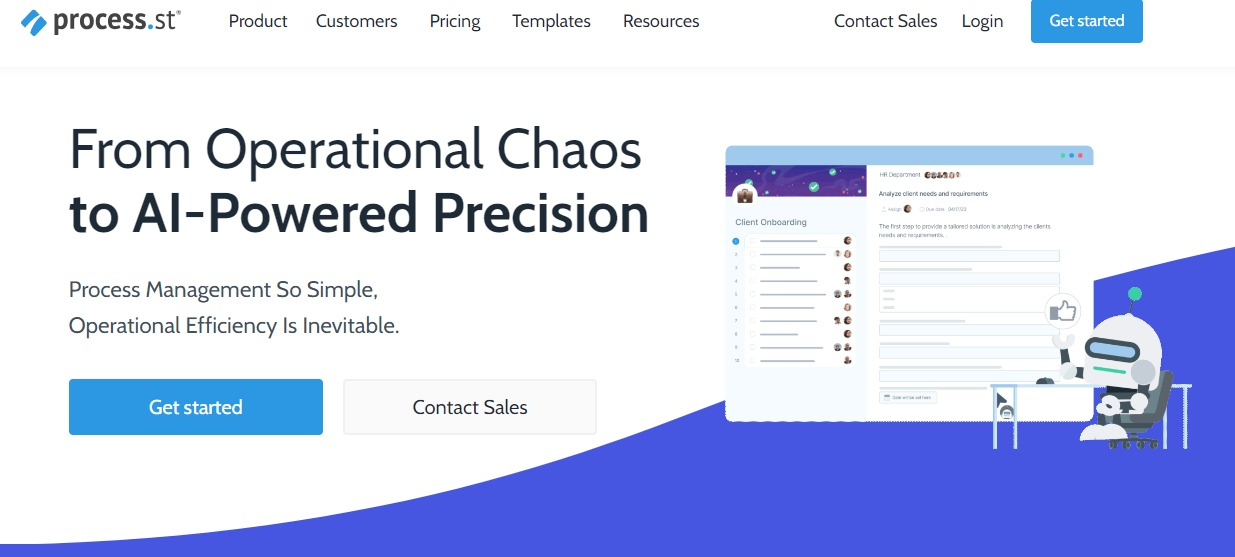
Jane Courtnell
Hi there, I am a Junior Content Writer at Process Street. I graduated in Biology, specializing in Environmental Science at Imperial College London. During my degree, I developed an enthusiasm for writing to communicate environmental issues. I continued my studies at Imperial College's Business School, and with this, my writing progressed looking at sustainability in a business sense. When I am not writing I enjoy being in the mountains, running and rock climbing. Follow me at @JaneCourtnell.